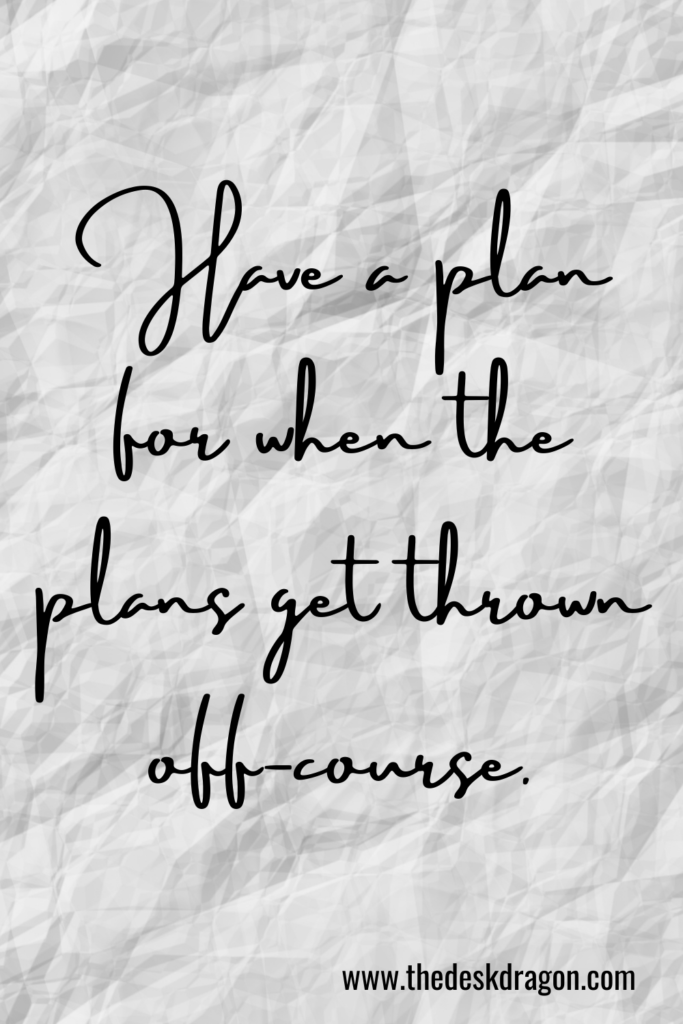How I Get Back on Track after a Major Detour
If you’re like me, you like plans. Making them, having them, carrying them out perfectly — plans make many of us feel in control and on top of things. But plans aren’t perfect. Very rarely do they turn out exactly the way we want them to. That’s why I’ve learned the value of having a plan to get back on track when my initial plans fall through. A plan for when the plans fail.
It’s a bit of an understatement to say things have not gone as planned in 2020. For anyone. In my previous post, I wrote about the importance of allowing for time to accept that we’re all struggling instead of trying to force positivity or an easy answer.
It’s okay and even healthy to pause and rest when life gets crazy. But we don’t have to stop there. When we’re ready, we can do our best to start moving forward again. We can get back on track one step at a time.
So in this post, I want to share my process for dealing with derailed plans. Here’s how I go from lost and overwhelmed to back on track and moving again.
Step 1: Get Your Bearings

Several years ago, I got lost while traveling alone in Kunming, China. I took the wrong bus and wound up at a terminal station with no idea what part of the city I was in. In that moment, my first priority was to find an internet connection so I could figure out 1) where I was, 2) which direction I needed to go, and 3) the best mode of transportation to get there.
I found a place with wi-fi easily enough, but my phone had trouble connecting to it. What followed was a long, frustrating afternoon that involved a few additional wrong turns. While I did eventually get to where I needed to go, because it took me so long to figure out where I even was, the whole process took a lot longer than expected.
The same is true of getting off-track in working towards our goals. If we keep blindly pushing forward without stopping to figure out where we actually are, we’re likely to end up in a similar position to me in Kunming: either walking aimlessly or on a bus that’s traveling in the exact opposite direction from my destination.
Now when my plans get derailed, I sit down as soon as I can and ask myself these questions:
- What was the original plan? I take out my bullet journal and review the goals and deadlines I laid out for myself. This step is much easier if you’ve written out your plan, but it’s still possible even if you haven’t.
- What has gone according to plan? It’s often more than I thought, which is encouraging to see.
- What has gotten delayed or derailed? Why and how? It’s important to be specific. Understanding how and why something went off-course makes it that much easier to know what needs to be done to correct it. Was it events outside of your control? Procrastination? Unforeseen difficulties? Something else?
Once I have a solid understanding of where I am and why, I can then start to evaluate where I want to be and how to get there.
Step 2: Set a New Course

Another problem I had that afternoon in Kunming was that I made getting back on track more complicated than it needed to be. What I should have done from the start — and what I wound up doing in the end — was navigating back to my hostel. From there, I could have planned out a route to the next location much more easily.
But that would have involved backtracking, and I didn’t want to spend so much time in transit. So instead, I tried to get to the next location from wherever-I-was, and wasted even more hours than I would have if I’d gone straight back to the hostel.
Similarly, a crucial step in getting plans back on track is to start over. Accept that you can no longer meet the original deadline, and then set new goals with new, reasonable deadlines.
Here I ask myself:
- Is there any part of the planned timeline I can still make happen? Again, there’s often more than I think there will be. Maybe something just needs to be delayed a little, or maybe there’s still time to meet the original deadline for one or two of my goals.
- Which parts of my original plan can no longer happen or are no longer my goal? Let them go. They’ll only distract you from what you can do.
- Which parts do I still need/want to accomplish? What steps do I need to take towards getting them done, and what is a reasonable timeline for getting them done with regard to the changed circumstances? Treat this exactly like your routine yearly, monthly, or weekly goal-setting time. Set new deadlines, break down larger goals or projects into smaller steps, and get started.
Congratulations, you’re back on track!


